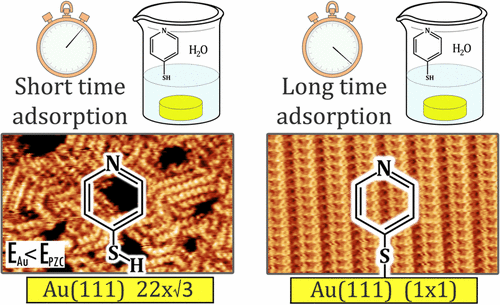Our official English website, www.x-mol.net, welcomes your
feedback! (Note: you will need to create a separate account there.)
Surface Structure of 4-Mercaptopyridine on Au(111): A New Dense Phase
Langmuir ( IF 3.7 ) Pub Date : 2017-09-13 00:00:00 , DOI: 10.1021/acs.langmuir.7b01627 Santiago Herrera 1 , Federico Tasca 1 , Federico J. Williams 1 , Ernesto J. Calvo 1 , Pilar Carro 2 , Roberto C. Salvarezza 3
Langmuir ( IF 3.7 ) Pub Date : 2017-09-13 00:00:00 , DOI: 10.1021/acs.langmuir.7b01627 Santiago Herrera 1 , Federico Tasca 1 , Federico J. Williams 1 , Ernesto J. Calvo 1 , Pilar Carro 2 , Roberto C. Salvarezza 3
Affiliation

|
4-Mercaptopyridine (4MPy) self-assembled on Au(111) has been studied by in situ electrochemical scanning tunneling microscopy (EC-STM) in HClO4, cyclic voltammetry, X-ray photoelectron spectroscopy (XPS) and density functional theory (DFT). Samples prepared by varying the immersion time at constant concentration named short time (30 s) and long time (3 min) adsorption have been studied. Cyclic voltammetry and XPS showed that the chemistry of the adsorbed molecules does not depend on the adsorption time resulting in a well established chemisorbed thiol self-assembled monolayer on Au(111). EC-STM study of the short time adsorption sample revealed a new self-assembled structure after a cathodic desorption/readsorption sweep, which remains stable only if the potential is kept negative to the Au(111) zero charge potential (EPZC). DFT calculations have shown a correlation between the observed structure and a dense weakly adsorbed phase with a surface coverage of θ = 0.4 and a (5 × √3) lattice configuration. At potentials positive to the EPZC, the weakly adsorbed state becomes unstable, and a different structure is formed due to the chemisorption driven by the electrostatic interaction. Long time adsorption experiments, on the other hand, have shown the typical (5 × √3) structure with θ = 0.2 surface coverage (chemisorbed phase) and are stable over the whole potential range. The difference observed in long time and short time immersion can be explained by the optimization of molecular interactions during the self-assembly process.
中文翻译:

4-巯基吡啶在Au(111)上的表面结构:一个新的致密相
通过原位电化学扫描隧道显微镜(EC-STM)在HClO 4中研究了在Au(111)上自组装的4-巯基吡啶(4MPy),循环伏安法,X射线光电子能谱(XPS)和密度泛函理论(DFT)。已经研究了通过以恒定浓度改变浸泡时间(称为短时间(30 s)和长时间(3 min))制备的样品。循环伏安法和XPS研究表明,吸附分子的化学性质不取决于吸附时间,从而导致在Au(111)上建立了良好的化学吸附硫醇自组装单分子层。短时间吸附样品的EC-STM研究表明,在阴极解吸/重吸收扫掠后出现了新的自组装结构,只有当电势保持为零的Au(111)零电荷电势(E PZC)。DFT计算显示观察到的结构与表面覆盖度为θ= 0.4且具有(5×√3)晶格构型的致密弱吸附相之间的相关性。在对E PZC为正的电势下,弱吸附状态变得不稳定,并且由于静电相互作用驱动的化学吸附,形成了不同的结构。另一方面,长时间的吸附实验表明,典型的(5×√3)结构的θ= 0.2表面覆盖率(化学吸附相),并且在整个电势范围内都是稳定的。在长时间和短时间浸入中观察到的差异可以通过自组装过程中分子相互作用的优化来解释。
更新日期:2017-09-13
中文翻译:

4-巯基吡啶在Au(111)上的表面结构:一个新的致密相
通过原位电化学扫描隧道显微镜(EC-STM)在HClO 4中研究了在Au(111)上自组装的4-巯基吡啶(4MPy),循环伏安法,X射线光电子能谱(XPS)和密度泛函理论(DFT)。已经研究了通过以恒定浓度改变浸泡时间(称为短时间(30 s)和长时间(3 min))制备的样品。循环伏安法和XPS研究表明,吸附分子的化学性质不取决于吸附时间,从而导致在Au(111)上建立了良好的化学吸附硫醇自组装单分子层。短时间吸附样品的EC-STM研究表明,在阴极解吸/重吸收扫掠后出现了新的自组装结构,只有当电势保持为零的Au(111)零电荷电势(E PZC)。DFT计算显示观察到的结构与表面覆盖度为θ= 0.4且具有(5×√3)晶格构型的致密弱吸附相之间的相关性。在对E PZC为正的电势下,弱吸附状态变得不稳定,并且由于静电相互作用驱动的化学吸附,形成了不同的结构。另一方面,长时间的吸附实验表明,典型的(5×√3)结构的θ= 0.2表面覆盖率(化学吸附相),并且在整个电势范围内都是稳定的。在长时间和短时间浸入中观察到的差异可以通过自组装过程中分子相互作用的优化来解释。











































 京公网安备 11010802027423号
京公网安备 11010802027423号